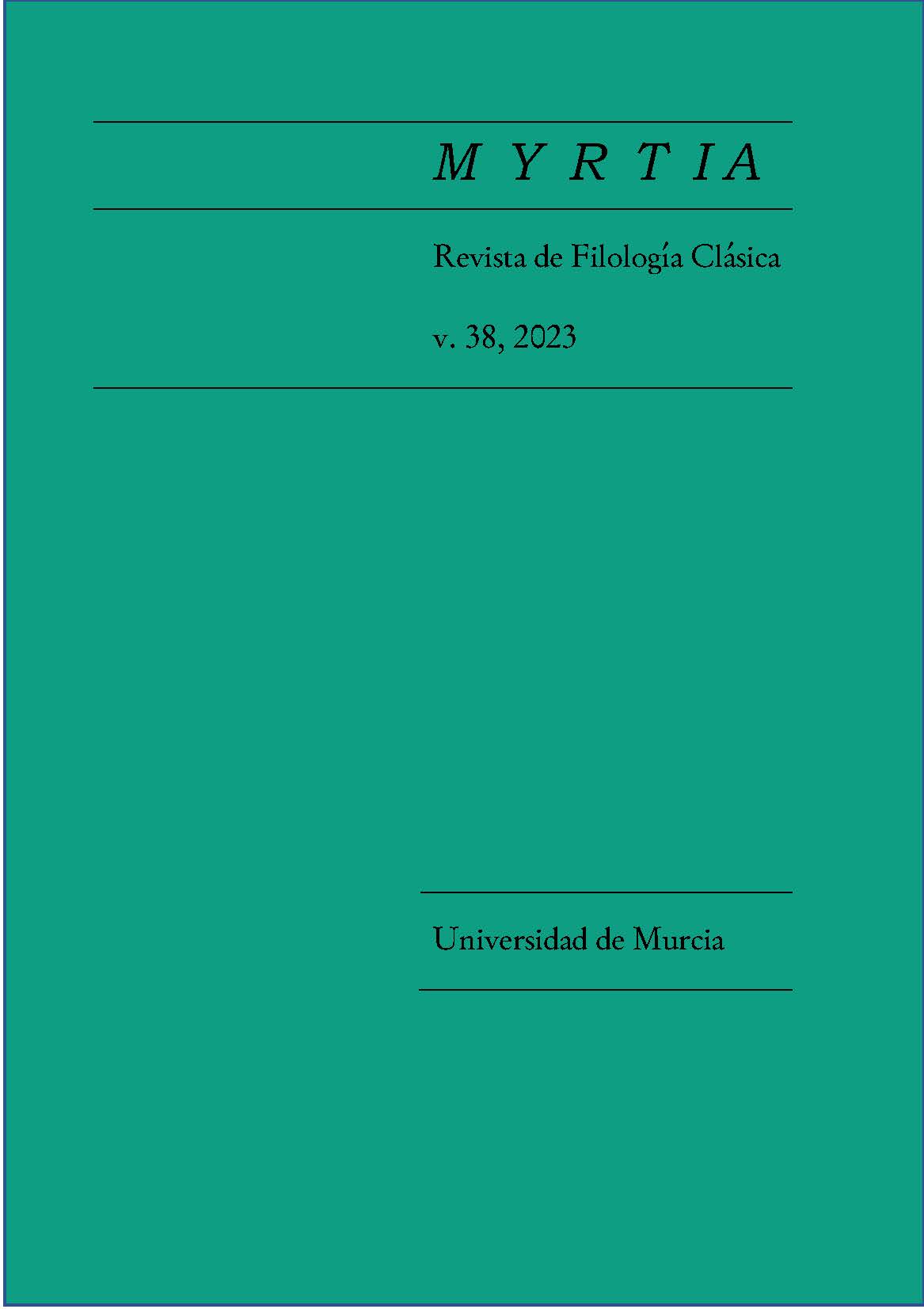Varium et Mutabile Semper Femina
Aristophanes’ Shapeshifting Lamia and Virgil’s Dido
Resumen
Una fuente olvidada, posible inspiración para Virgilio en la composición de su reina cartaginesa Dido, es la tríada de monstruos folclóricos asesinos de niños conocida por las citas de la comedia aristofánica. El hecho de que Virgilio recurra a la tradición popular sobre la reina libia Lamia y su transformación en un monstruo de pesadilla resalta la metamorfosis de Dido desde gobernante responsable de su pueblo a enemiga de Eneas y sus descendientes, furiosa y amargada. Además, Virgilio puede aludir específicamente a la naturaleza cambiante de estos monstruos mitológicos en la advertencia misógina de Mercurio a Eneas sobre la eminente mutabilidad de las mujeres.
Descargas
-
Resumen767
-
pdf469
Citas
W.S. Anderson, 1981, “Servius and the ‘Comic Style’ of Aeneid 4,” Arethusa 14, pp. 115-25.
P.M. Astorino, 2020, “Dido como alusión a Cleopatra en la Eneida,” Myrtia 35, pp. 275-92.
C. Austin and S.D. Olson, eds., 2004, Aristophanes Thesmophoriazusae, Oxford.
R.G. Austin, ed., 1955, P. Vergili Maronis Aeneidos Liber Quartus, Oxford.
Z.P. Biles and S.D. Olson, eds., 2015, Aristophanes Wasps, Oxford.
G. Binder, ed., 2000, Dido und Aeneas: Vergils Dido-Drama und Aspekte seiner Rezeption. Trier.
H. Björklund, 2017, “Metamorphosis, Mixanthropy and the Child-Killing Demon in the Hellenistic and Byzantine Periods,” in Acta Classica 60, pp. 22-49.
E.K. Borthwick, 1968, “Seeing Weasels: The Superstitious Background of the Empusa Scene in the Frogs,” The Classical Quarterly 18, pp. 200-6.
A.J. Boyle, ed., 2019, Seneca Agamemnon, Oxford.
C. Bourquin, 2019, Humor in der Aeneis, Berlin.
C.O. Brink, ed., 1971, Horace on Poetry: The Ars Poetica, Cambridge.
C.G. Brown, 1991, “Empousa, Dionysus and the Mysteries: Aristophanes, Frogs 285 ff.,” The Classical Quarterly 41, pp. 41-50.
C. Buscaroli, 1932, Il libro di Didone: Testo con traduzione a fronte seguito da ampio commento interpretativo ed estetico, Milano-Genova-Roma-Napoli.
R. Buxton, 2009, Forms of Astonishment: Greek Myths of Metamorphosis, Oxford.
C. Collard, 1975, “Medea and Dido,” Prometheus 1, pp. 131-51.
M. Davies and P.J. Finglass, eds., 2017, Stesichorus: The Poems, Cambridge.
K.J. Dover, ed., 1993, Aristophanes Frogs, Oxford.
N. Dunbar, ed., 1997, Aristophanes Birds, Oxford.
D. Felton, 2013, “Apuleius’ Cupid Considered as a Lamia (Metamorphoses 5.17-8),” Illinois Classical Studies 38, 229-44.
J. Ferriss-Hill, 2019, Horace’s Ars Poetica: Family, Friendship, and the Art of Living, Princeton.
L.M. Fratantuono, 2009, “Chiastic Doom in the Aeneid,” Latomus 68, pp. 393-401.
L.M. Fratantuono, 2022, “‘Plautinisches im Vergil’: Comic Influence on Aeneid 4,” Živa Antika 72, pp. 77-90.
L.M. Fratantuono and R.A. Smith, eds., 2022, Virgil: Aeneid 4, Text, Translation, and Commentary, Leiden-Boston.
E. Giusti, 2018, Carthage in Virgil’s Aeneid: Staging the Enemy under Augustus, Cambridge.
A.S.F. Gow, ed., 1952, Theocritus, Cambridge.
J. Henderson, ed., 1987, Aristophanes Lysistrata, Oxford.
S. Heyworth and J.H.W. Morwood, eds., 2011, A Commentary on Propertius Book 3, Oxford.
S.I. Johnson, 1995, “Defining the Dreadful: Remarks on the Greek Child-Killing Demons,” in M. Meyer and P. Mirecki, eds., Ancient Magic and Ritual Power, Leiden-New York-Köln.
S.I. Johnston, 1999, “Childless Mothers and Blighted Virgins: Female Ghosts and Their Victims,” in S.I. Johnston, ed., Restless Dead: Encounters between the Living and the Dead in Ancient Greece, Berkeley-Los Angeles-London, pp. 161-200.
J. Kowalski, 1929, De Didone graeca et Latina, Cracow.
R.B. Lloyd, 1984, “Comico, stile,” in F. Della Corte, ed., Enciclopedia virgiliana, Vol. I, Roma, pp. 853-5.
D.M. MacDowell, ed., 1971, Aristophanes Wasps, Oxford.
R. Monti, 1981, The Dido Episode and the Aeneid: Roman Social and Political Values in the Epic, Leiden.
J. Newman and F. Newman, 2005, Troy’s Children: Lost Generations in Virgil’s Aeneid. Hildesheim-Zürich-New York.
R.G.M. Nisbet and M. Hubbard, eds., 1970, A Commentary on Horace Odes Book 1, Oxford.
D. Ogden, 2013, Dragons, Serpents, & Slayers in the Classical and Early Christian Worlds: A Sourcebook, Oxford.
S.D. Olson, ed., 1998, Aristophanes Peace, Oxford.
S.D. Olson, ed., 2002, Aristophanes Acharnians, Oxford.
M. Patera, 2015, “Mormô l’épouvantail,” in M. Patera, ed., Figures grecques de l’épouvante de l’antiquité au present: peurs enfantines et adultes, Leiden-Boston, pp. 106-44.
M.T. Paule, 2013, “Quae saga, quis magus: On the Vocabulary of the Roman Witch,” The Classical Quarterly 64, pp. 745-57.
A.S. Pease, 1935, P. Vergili Maronis Aeneidos Liber Quartus, Cambridge, Massachusetts.
M. Platnauer, ed., 1964, Aristophanes Peace, Oxford.
A. Schiesaro, 2008, “Furthest Voices in Virgil’s Dido,” Studi italiani di filologia 6, pp. 86-90.
A. Schmitz, 1960, Infelix Dido, Gembloux.
W.B. Stanford, ed., 1963, Aristophanes Frogs, London.
J. Stern, 2003, “Heraclitus the Paradoxographer: ‘On Unbelievable Tales,’” in Transactions of the American Philological Association 133, pp. 51-97.
R.G. Ussher, ed., 1973, Aristophanes Ecclesiazusae, Oxford.
A.J. Woodman, ed., 2020, Horace Odes Book III, Cambridge.
R. Wyles, 2020, Theatre Props and Civic Identity in Athens, 458-405 BC, London.
Las obras que se publican en esta revista están sujetas a los siguientes términos:
1. El Servicio de Publicaciones de la Universidad de Murcia (la editorial) conserva los derechos patrimoniales (copyright) de las obras publicadas, y favorece y permite la reutilización de las mismas bajo la licencia de uso indicada en el punto 2.
2. Las obras se publican en la edición electrónica de la revista bajo una licencia Creative Commons Reconocimiento-NoComercial-SinObraDerivada 3.0 España (texto legal). Se pueden copiar, usar, difundir, transmitir y exponer públicamente, siempre que: i) se cite la autoría y la fuente original de su publicación (revista, editorial y URL de la obra); ii) no se usen para fines comerciales; iii) se mencione la existencia y especificaciones de esta licencia de uso.
3. Condiciones de auto-archivo. Se permite y se anima a los autores a difundir electrónicamente las versiones pre-print (versión antes de ser evaluada) y/o post-print (versión evaluada y aceptada para su publicación) de sus obras antes de su publicación, ya que favorece su circulación y difusión más temprana y con ello un posible aumento en su citación y alcance entre la comunidad académica. Color RoMEO: verde.





